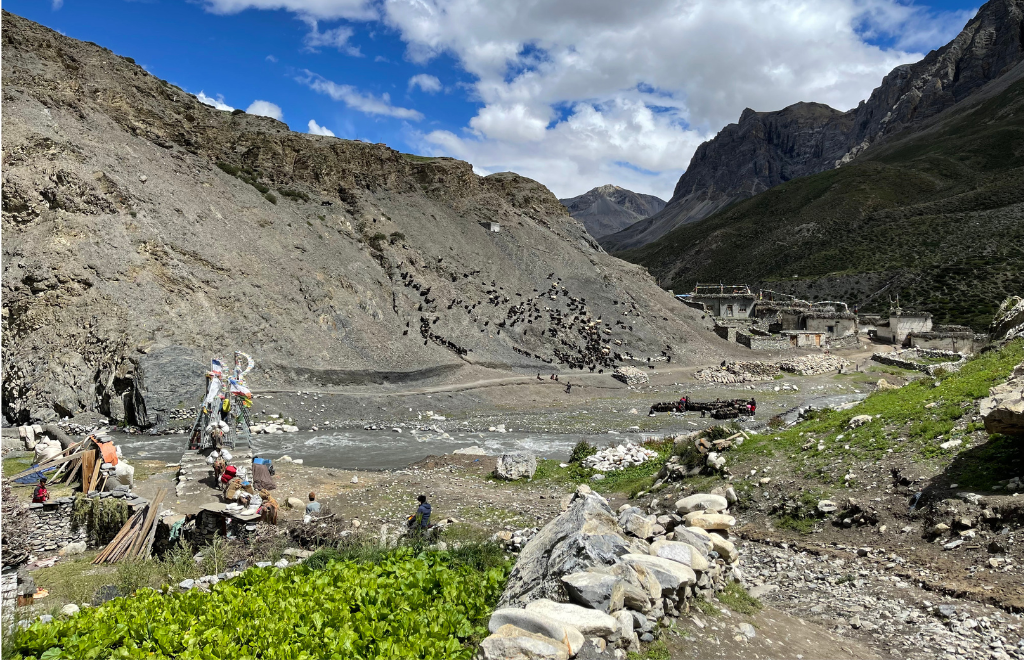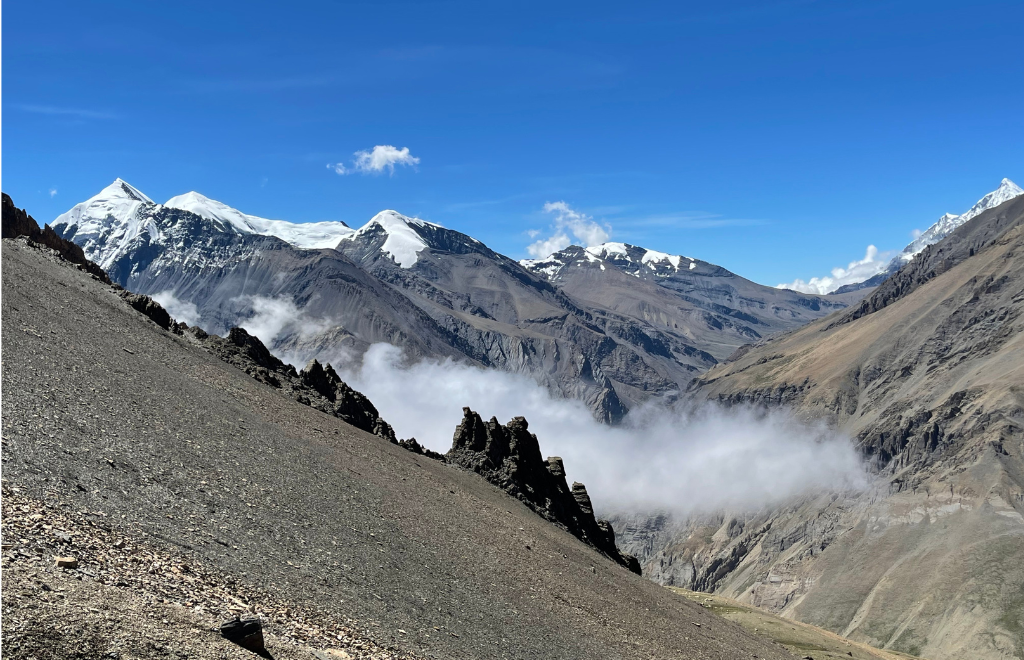Upper Mustang Lo Manthang, Nepal, is a legendary Himalayan kingdom tucked in the far north of Nepal. Nestled in the Trans-Himalayan region, this ancient walled city is the cultural heart of Upper Mustang and is known for its stark desert-like landscapes, centuries-old Tibetan Buddhist monasteries, and the rich heritage of the once-forbidden Kingdom of Lo.
Upper Mustang lies in the northwestern part of Nepal, within the Mustang District of Gandaki Province. It is nestled in the rain shadow of the Annapurna and Dhaulagiri ranges, bordering the Tibetan plateau of China. The region is culturally and geographically distinct from the rest of Nepal, often referred to as the “Last Forbidden Kingdom.”
The main highlight of Upper Mustang is Lo Manthang, a fortified medieval city that was once the capital of the ancient Kingdom of Lo. This remote area was restricted to outsiders until 1992, helping preserve its Tibetan-Buddhist culture, architecture, and language.
Unlike other parts of Nepal, Lo Manthang offers a rare chance to explore a remote world through trekking that feels untouched by modern life. The journey to reach this hidden gem isn’t easy, but that’s part of the magic. Travelers can choose a variety of routes that combine scenic flights, bumpy overland drives, and immersive treks through some of the most dramatic landscapes Nepal has to offer.
Reaching Lo Manthang is a true adventure, beginning in Kathmandu, transitioning through the peaceful lakeside city of Pokhara, then moving through the rugged terrain of Jomsom before finally arriving in the ancient kingdom itself. This guide will take you through each leg of the journey, outline travel options, necessary permits, and offer practical tips to help you get the most out of your visit to one of Nepal’s most extraordinary destinations.
If you're ready to uncover a piece of history nestled in the shadows of the Himalayas, read on. This is your ultimate travel guide to reaching Upper Mustang, Lo Manthang, Nepal.
Interested in Visiting Lo Manthang Upper Mustang?
We at A1 Excursion Adventure offer carefully curated Upper Mustang treks designed to match your style of travel, from immersive trekking experiences to cultural jeep tours.
Explore Our Top Upper Mustang Packages:

Where is Upper Mustang, and Why Visit It?
Upper Mustang is located in the northwestern region of Nepal, within the Mustang District of Gandaki Province. It lies in the rain shadow of the Annapurna and Dhaulagiri mountain ranges and borders the Tibetan Plateau of China. This remote Himalayan region is culturally and geographically distinct, often referred to as “The Last Forbidden Kingdom.”
At the heart of Upper Mustang is Lo Manthang, a fortified medieval city that once served as the capital of the ancient Kingdom of Lo. Closed to outsiders until 1992, the region has preserved its Tibetan Buddhist culture, language, and architecture with remarkable authenticity. Due to its isolation and restricted access, Upper Mustang offers a glimpse into a way of life that has remained virtually unchanged for centuries.
Even today, visiting Upper Mustang feels like stepping into a living museum of Himalayan heritage. Travelers are drawn not only by its ancient cultural treasures but also by its surreal desert-like landscapes and spiritual atmosphere.
Why Visit Upper Mustang?
- Walk through the cobbled alleys of Lo Manthang’s ancient walled city
- Visit centuries-old monasteries and explore mysterious sky caves
- Experience authentic Tibetan Buddhist rituals and village life
- Enjoy the cinematic beauty of eroded cliffs, dry riverbeds, and Himalayan peaks
- Witness vibrant local festivals like the Tiji Festival and Yarthung Festival
Travel Routes to Lo Manthang: From Kathmandu to the Forbidden Kingdom
The journey to Lo Manthang Upper Mustang typically begins in Kathmandu, continues through Pokhara and Jomsom, and finally leads you into Upper Mustang either by trekking or overland drive. Here’s a detailed breakdown of each leg:
Step 1: Kathmandu to Pokhara
- By Air: A 25–30 minute flight from Tribhuvan International Airport to Pokhara Airport. Multiple daily flights are available via Buddha Air, Yeti Airlines, and others.
- By Road: A scenic 6–8 hour drive along the Prithvi Highway. Tourist buses and private cars are available.
Tip: Flying saves time and offers magnificent aerial views of the Himalayas.
Step 2: Pokhara to Jomsom
- By Air: The quickest and most scenic route. A 20-minute flight takes you through the Kali Gandaki Gorge with views of the Dhaulagiri and Annapurna ranges.
- By Jeep: Ideal for adventure seekers. The road is bumpy and prone to landslides, especially during the monsoon.
- By Bus: Budget-friendly but less comfortable. Suitable for those with flexible schedules.
Note: Flights can be delayed or canceled due to strong winds and unpredictable weather.
Step 3: Jomsom to Lo Manthang
Once in Jomsom, you have two primary options:
a) Trekking to Lo Manthang
- Duration: 7 - 8 days
- Route: Jomsom → Kagbeni → Chele → Syangbochen → Ghami → Tsarang → Lo Manthang
- Highlights: Immersive cultural experience, dramatic landscapes, Buddhist monasteries, and remote villages
b) Overland Drive to Lo Manthang
- Duration: 2–3 days
- Vehicle: Private jeep or shared vehicle
- Route: Jomsom → Kagbeni → Ghiling → Charang → Lo Manthang
- Benefits: Ideal for those short on time or unable to trek long distances
Upper Mustang Distance: How Far Is It from Pokhara and Kagbeni to Lo Manthang?
Planning your journey to Upper Mustang means understanding the distances and travel options available to reach Lo Manthang, the region’s cultural heart. Whether you prefer an adventurous jeep drive or a scenic trek, knowing the routes, distances, and travel times will help you prepare better for this unique Himalayan expedition.
By Road (Jeep Drive)
- Pokhara to Lo Manthang: Approximately 375 km
1. Travel Time: 2 to 3 days, depending on road conditions and weather
2. Route: Pokhara → Beni → Jomsom → Kagbeni → Ghiling → Lo Manthang
The roads can be rugged and rough, so a sturdy 4WD jeep is necessary for this off-road journey.
- Kagbeni to Lo Manthang: Around 75–85 km
1. Travel Time: 6 to 8 hours
This section involves challenging terrain, making a 4-wheel drive (4WD) vehicle essential for a safe and comfortable drive.
By Trekking
- Pokhara to Lo Manthang (via Jomsom): Typically completed in 18 to 20 days by trekking enthusiasts seeking an immersive experience.
- Jomsom to Lo Manthang Trekking Distance: Roughly 80 to 100 km, depending on the chosen path and side excursions.
- Duration: Usually 7 to 8 days from Jomsom to Lo Manthang.
- Popular Trekking Route: Jomsom → Kagbeni → Chele → Syangbochen → Ghami → Tsarang → Lo Manthang
This trek offers breathtaking landscapes, cultural immersion, and access to remote villages and monasteries.

Essential Permits for Upper Mustang Travel
To visit Upper Mustang Lo Manthang, Nepal, special permits are mandatory due to its status as a restricted area. You’ll need a Restricted Area Permit (RAP), which costs USD 500 per person for the first 10 days, and an Annapurna Conservation Area Permit (ACAP) priced at USD 30. A TIMS card is also required, though it’s usually arranged by your trekking agency, like A1 Excursion Adventure.
Note: You must travel with a registered trekking agency and a licensed guide. Solo trekking is not allowed.
Weather and Temperature in Upper Mustang, Nepal
Upper Mustang, located in the rain shadow of the Annapurna and Dhaulagiri ranges, experiences a dry, wind-swept climate with minimal rainfall year-round. Due to its high altitude, temperatures vary significantly between day and night. Spring and autumn are considered the best seasons to visit, offering mild weather, clear skies, and excellent trekking conditions. Summer remains relatively dry but can bring strong winds and occasional road disruptions. Winter is freezing, with temperatures dropping as low as -15°C, and many lodges in the region close during this season.
Seasonal Weather and Temperature Overview
| Season | Temperature Range (°C) | Weather Description | Travel Recommendation |
Spring (Mar–May) | 0°C to 18°C | Mild temperatures, blooming landscapes, clear skies | Recommended for trekking and sightseeing |
Summer (Jun–Aug) | 5°C to 20°C | Dry with strong winds, occasional road issues | Possible delays; still accessible |
Autumn (Sep–Nov) | -2°C to 17°C | Crisp air, clear views, vibrant festivals | Best season for travel |
Winter (Dec–Feb) | -15°C to 5°C | Harsh cold, snow in high areas, and limited accommodation | Not recommended |
Travel Tips for a Safe and Respectful Mustang Trek
Planning a trek to Upper Mustang? This remote and culturally rich region requires preparation. Here are some essential travel tips to make your journey smoother and more enjoyable:
- Altitude Acclimatization- Spend a day or two in places like Jomsom or Kagbeni before ascending further. This helps your body adjust and reduces the risk of altitude sickness.
- Cash is King- ATMs are rare and often unreliable beyond Jomsom. Carry enough Nepali rupees for your entire trek, including meals, permits, and additional expenses.
- Limited Connectivity- Mobile and internet coverage are patchy in Upper Mustang. Carry a local NTC SIM card for better signal, and always share your emergency plan with your guide.
- Cultural Sensitivity- Respect the local Tibetan Buddhist culture. Always ask before taking photos of people or inside monasteries, and follow customs around religious sites and prayer flags.
Final Thoughts
Visiting Lo Manthang in Mustang, Nepal, is more than just reaching a destination.
It’s like walking into a place where time has stood still. From sacred sky caves and vibrant local festivals to breathtaking Himalayan views and rich Tibetan traditions, the journey to Upper Mustang is a deeply moving experience.
Whether you choose to trek, fly, or drive, each route to Lo Manthang offers something unique and unforgettable. Plan your trip, secure your permits, and get ready for a journey that connects you with nature, culture, and yourself.
Ready to explore the magic of Mustang? Contact A1 Excursion Adventure today and let us help you plan the perfect Upper Mustang trek.
FAQs Frequently Asked Questions
1. How do I get to Lo Manthang from Kathmandu?
To reach Lo Manthang from Kathmandu, you typically take a domestic flight to Pokhara, then another short flight to Jomsom. From Jomsom, you can either trek for about 5-7 days or take a jeep over 2-3 days to Lo Manthang. Each option offers unique views and experiences of Nepal’s rugged terrain.
2. Is Lo Manthang open to foreign tourists?
Yes, Lo Manthang has been open to foreign tourists since 1992, but it remains a restricted area. Visitors need special permits to enter, and solo trekking is not allowed. Travel is usually arranged through licensed trekking agencies.
3. Do I need a special permit to visit Upper Mustang?
Yes, visiting Upper Mustang requires a Restricted Area Permit (RAP) costing around USD 500 for 10 days, an Annapurna Conservation Area Permit (ACAP), and a TIMS card. Permits are usually arranged by your trekking agency, and you must travel with a registered guide.
4. What is the best time to visit Lo Manthang, Mustang?
The best times to visit are spring (March to May) and autumn (September to November). These seasons offer mild weather, clear skies, and vibrant festivals. The monsoon season (June to August) is not recommended due to landslides and slippery trails.
5. Can I drive to Lo Manthang, or is trekking the only option?
Both options are available. You can trek for 5-7 days or take an overland jeep tour that takes 2-3 days. Jeep tours are great for travelers short on time or who prefer less physical exertion, while trekking offers deeper cultural immersion.
6. How much does it cost to trek to Upper Mustang?
Trekking costs vary but generally range from USD 1500 to 2500 for a 10-18 day trek, including permits, guide fees, accommodation, and meals. Costs can be higher due to the restricted area permits and the remote location.
7. How many days does it take to reach Lo Manthang by trek?
It usually takes about 5 to 7 days to trek from Jomsom to Lo Manthang, depending on your pace and acclimatization needs. Many trekkers spend additional days exploring Mustang before returning.
8. Is it safe to travel to Upper Mustang alone?
No, solo trekking in Upper Mustang is not allowed due to government regulations. Trekkers must travel in groups of at least two with a licensed guide to ensure safety and cultural respect.
9. What should I pack for a trip to Lo Manthang, Mustang, Nepal?
Pack layered clothing for varying temperatures, sturdy trekking boots, sun protection, a warm jacket for high altitudes, a good backpack, a first aid kit, and enough cash since ATMs are unreliable. Also, carry a local SIM card for limited connectivity.
10. Which festivals can I experience in Lo Manthang?
The most famous festival is the Tiji Festival, held every May for three days. It features vibrant masked dances, rituals, and prayers symbolizing the victory of good over evil. Experiencing Tiji offers deep cultural insight and unforgettable memories.





-1.webp)
-1.webp)
.webp)